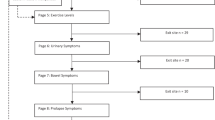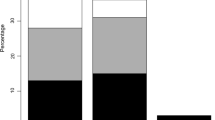Abstract
Introduction and hypothesis
Urinary incontinence (UI) is prevalent in sport students. We hypothesized that pelvic floor muscle training (PFMT) can improve pelvic floor muscle (PFM) strength and symptoms of UI in this group of physically active women.
Methods
Sixteen sport students with UI participated in this pre-post test pilot study. However, only seven of them, mean age 20.0 ± 0.8 years, completed the 8-week program. Activity level was measured by the International Physical Activity Questionnaire-Short Form (IPAQ-SF). The outcome measure was the International Consultation on Incontinence Questionnaire-Short Form (ICIQ UI SF). PFM strength was measured by manometry as maximum voluntary contraction (MVC).
Results
Vaginal resting pressure improved by 17.4 cmH2O (SD 6.7), p = 0.04 and MVC by 16.4 cmH2O (SD 5.8), p = 0.04. ICIQ UI SF score, frequency, and amount of leakage showed statistically significant improvement.
Conclusions
PFMT increased PFM strength and reduced frequency and amount of UI episodes in sport students that completed an 8-week PFMT program. Randomized controlled trials are warranted to confirm these results.
Similar content being viewed by others
References
Haylen BT, de Ridder D, Freeman RM, Swift SE, Berghmans B, Lee J, Monga A, Petri E, Rizk DE, Sand PK, Schaer GN (2010) An International Urogynecological Association (IUGA)/International Continence Society (ICS) joint report on the terminology for female pelvic floor dysfunction. Int Urogynecol J 21(1):5–26
Jackson S (2005) Stress urinary incontinence: new management options. Curr Med Res Opin 21(10):1669–1675
Wyman JF, Harkins SW, Fantl JA (1990) Psychosocial impact of urinary incontinence in the community-dwelling population. J Am Geriatr Soc 38(3):282–288
Bø K, Mæhlum S, Oseid S, Larsen S (1989) Prevalence of stress urinary incontinence among physically active and sedentary female students. Scand J Sports Sci 11:113–116
Thyssen HH, Clevin L, Olesen S, Lose G (2002) Urinary incontinence in elite female athletes and dancers. Int Urogynecol J Pelvic Floor Dysfunct 13(1):15–17
Eliasson K, Nordlander I, Larson B, Hammarström M, Mattsson E (2005) Influence of physical activity on urinary leakage in primiparous women. Scand J Med Sci Sports 15(2):87–94
Bø K, Sundgot-Borgen J (2010) Are former female elite athletes more likely to experience urinary incontinence later in life than non-athletes? Scand J Med Sci Sports 20(1):100–104
Nygaard I, DeLancey JO, Arnsdorf L, Murphy E (1990) Exercise and incontinence. Obstet Gynecol 75(5):848–851
Bø K, Hagen R, Kvarstein B, Larsen S (1989) Female stress urinary incontinence and participation in different sport and social activities. Scand J Sports Sci 11:117–121
Bø K, Bratland-Sanda S, Sundgot-Borgen J (2011) Urinary incontinence among group fitness instructors including yoga and pilates teachers. Neurourol Urodyn 30(3):370–373
Nygaard IE, Thompson FL, Svengalis SL, Albright JP (1994) Urinary incontinence in elite nulliparous athletes. Obstet Gynecol 84(2):183–187
Hay-Smith J, Berghmans B, Burgio KL, Dumoulin C, Hagen S, Moore K, Nygaard I, N’Dow J (2009) Adult Conservative Management. In: Abrams P, Cardozo L, Houry S, Wein A (eds) 4th International Consultation on Incontinence, vol 4, vol 12, 4th edn. Health Publication Ltd, Paris, pp 1025–1120
Ree ML, Nygaard I, Bø K (2007) Muscular fatigue in the pelvic floor muscles after strenuous physical activity. Acta Obstet Gynecol Scand 86(7):870–876
Rivalta M, Sighinolfi MC, Micali S, De Stefani S, Torcasio F, Bianchi G (2010) Urinary incontinence and sport: first and preliminary experience with a combined pelvic floor rehabilitation program in three female athletes. Health Care Women Int 31(5):435–443
Craig CL, Marshall AL, Sjöström M, Bauman AE, Booth ML, Ainsworth BE, Pratt M, Ekelund U, Yngve A, Sallis JF, Oja P (2003) International physical activity questionnaire: 12-country reliability and validity. Med Sci Sports Exerc 35(8):1381–1395
Avery K, Donovan J, Peters TJ, Shaw C, Gotoh M, Abrams P (2004) ICIQ: a brief and robust measure for evaluating the symptoms and impact of urinary incontinence. Neurourol Urodyn 23(4):322–330
Tamanini JT, Dambros M, D’Ancona CA, Palma PC, Rodrigues Netto N Jr (2004) Validation of the “International Consultation on Incontinence Questionnaire – Short Form” (ICIQ-SF) for Portuguese. Rev Saude Publica 38(3):438–444
Bø K, Kvarstein B, Hagen R et al (1990) Pelvic floor muscle exercise for the treatment of female stress urinary incontinence: II. Validity of vaginal pressure measurements of pelvic floor muscle strength and the necessity of supplementary methods for control of correct contraction. Neurourol Urodyn 9(5):479–487
Frawley HC, Galea MP, Phillips BA, Sherburn M, Bø K (2006) Reliability of pelvic floor muscle strength assessment using different test positions and tools. Neurourol Urodyn 25(3):236–242
Ferreira CH, Barbosa PB, de Oliveira Souza F, Antônio FI, Franco MM, Bø K (2011) Inter-rater reliability study of the modified Oxford Grading Scale and the Peritron manometer. Physiotherapy 97(2):132–138
Bø K (2004) Urinary incontinence, pelvic floor dysfunction, exercise and sport. Sports Med 34(7):451–464
Hay JG (1993) Citius, altius, longius (faster, higher, longer): the biomechanics of jumping for distance. J Biomech 26(Suppl 1):7–21
Bø K, Stien R, Kulseng-Hanssen S, Kristofferson M (1994) Clinical and urodynamic assessment of nulliparous young women with and without stress incontinence symptoms: a case-control study. Obstet Gynecol 84(6):1028–1032
Keane DP, Sims TJ, Abrams P, Bailey AJ (1997) Analysis of collagen status in premenopausal nulliparous women with genuine stress incontinence. Br J Obstet Gynaecol 104(9):994–998
Kegel AH (1951) Physiologic therapy for urinary stress incontinence. J Am Med Assoc 146(10):915–917
Chiarelli P, Murphy B, Cockburn J (2003) Women’s knowledge, practises, and intentions regarding correct pelvic floor exercises. Neurourol Urodyn 22(3):246–249
Bø K, Borgen JS (2001) Prevalence of stress and urge urinary incontinence in elite athletes and controls. Med Sci Sports Exerc 33(11):1797–1802
Eliasson K, Edner A, Mattsson E (2008) Urinary incontinence in very young and mostly nulliparous women with a history of regular organised high-impact trampoline training: occurrence and risk factors. Int Urogynecol J Pelvic Floor Dysfunct 19(5):687–696
Conflicts of interest
None.
Author information
Authors and Affiliations
Corresponding author
Rights and permissions
About this article
Cite this article
Da Roza, T., de Araujo, M.P., Viana, R. et al. Pelvic floor muscle training to improve urinary incontinence in young, nulliparous sport students: a pilot study. Int Urogynecol J 23, 1069–1073 (2012). https://doi.org/10.1007/s00192-012-1759-2
Received:
Accepted:
Published:
Issue Date:
DOI: https://doi.org/10.1007/s00192-012-1759-2




